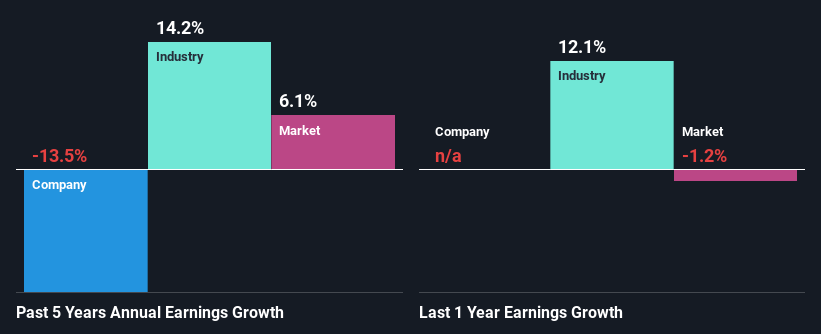- China
- /
- Semiconductors
- /
- SHSE:688766
Puya Semiconductor (Shanghai) Co., Ltd.'s (SHSE:688766) Stock Has Seen Strong Momentum: Does That Call For Deeper Study Of Its Financial Prospects?

Puya Semiconductor (Shanghai)'s (SHSE:688766) stock is up by a considerable 37% over the past three months. Given that stock prices are usually aligned with a company's financial performance in the long-term, we decided to study its financial indicators more closely to see if they had a hand to play in the recent price move. In this article, we decided to focus on Puya Semiconductor (Shanghai)'s ROE.
Return on Equity or ROE is a test of how effectively a company is growing its value and managing investors’ money. In short, ROE shows the profit each dollar generates with respect to its shareholder investments.
View our latest analysis for Puya Semiconductor (Shanghai)
How Is ROE Calculated?
ROE can be calculated by using the formula:
Return on Equity = Net Profit (from continuing operations) ÷ Shareholders' Equity
So, based on the above formula, the ROE for Puya Semiconductor (Shanghai) is:
13% = CN¥278m ÷ CN¥2.2b (Based on the trailing twelve months to September 2024).
The 'return' refers to a company's earnings over the last year. That means that for every CN¥1 worth of shareholders' equity, the company generated CN¥0.13 in profit.
What Is The Relationship Between ROE And Earnings Growth?
So far, we've learned that ROE is a measure of a company's profitability. Based on how much of its profits the company chooses to reinvest or "retain", we are then able to evaluate a company's future ability to generate profits. Generally speaking, other things being equal, firms with a high return on equity and profit retention, have a higher growth rate than firms that don’t share these attributes.
Puya Semiconductor (Shanghai)'s Earnings Growth And 13% ROE
To begin with, Puya Semiconductor (Shanghai) seems to have a respectable ROE. Further, the company's ROE compares quite favorably to the industry average of 6.4%. As you might expect, the 14% net income decline reported by Puya Semiconductor (Shanghai) is a bit of a surprise. We reckon that there could be some other factors at play here that are preventing the company's growth. For example, it could be that the company has a high payout ratio or the business has allocated capital poorly, for instance.
So, as a next step, we compared Puya Semiconductor (Shanghai)'s performance against the industry and were disappointed to discover that while the company has been shrinking its earnings, the industry has been growing its earnings at a rate of 14% over the last few years.

Earnings growth is a huge factor in stock valuation. The investor should try to establish if the expected growth or decline in earnings, whichever the case may be, is priced in. By doing so, they will have an idea if the stock is headed into clear blue waters or if swampy waters await. If you're wondering about Puya Semiconductor (Shanghai)'s's valuation, check out this gauge of its price-to-earnings ratio, as compared to its industry.
Is Puya Semiconductor (Shanghai) Making Efficient Use Of Its Profits?
When we piece together Puya Semiconductor (Shanghai)'s low three-year median payout ratio of 10% (where it is retaining 90% of its profits), calculated for the last three-year period, we are puzzled by the lack of growth. This typically shouldn't be the case when a company is retaining most of its earnings. So there might be other factors at play here which could potentially be hampering growth. For instance, the business has faced some headwinds.
In addition, Puya Semiconductor (Shanghai) has been paying dividends over a period of three years suggesting that keeping up dividend payments is preferred by the management even though earnings have been in decline.
Conclusion
On the whole, we do feel that Puya Semiconductor (Shanghai) has some positive attributes. Yet, the low earnings growth is a bit concerning, especially given that the company has a high rate of return and is reinvesting ma huge portion of its profits. By the looks of it, there could be some other factors, not necessarily in control of the business, that's preventing growth. That being so, the latest industry analyst forecasts show that the analysts are expecting to see a huge improvement in the company's earnings growth rate. Are these analysts expectations based on the broad expectations for the industry, or on the company's fundamentals? Click here to be taken to our analyst's forecasts page for the company.
New: Manage All Your Stock Portfolios in One Place
We've created the ultimate portfolio companion for stock investors, and it's free.
• Connect an unlimited number of Portfolios and see your total in one currency
• Be alerted to new Warning Signs or Risks via email or mobile
• Track the Fair Value of your stocks
Have feedback on this article? Concerned about the content? Get in touch with us directly. Alternatively, email editorial-team (at) simplywallst.com.
This article by Simply Wall St is general in nature. We provide commentary based on historical data and analyst forecasts only using an unbiased methodology and our articles are not intended to be financial advice. It does not constitute a recommendation to buy or sell any stock, and does not take account of your objectives, or your financial situation. We aim to bring you long-term focused analysis driven by fundamental data. Note that our analysis may not factor in the latest price-sensitive company announcements or qualitative material. Simply Wall St has no position in any stocks mentioned.
About SHSE:688766
Puya Semiconductor (Shanghai)
Engages in research, development, design, and sale of non-volatile memory chips and memory based derivative chips in China and internationally.
Flawless balance sheet with high growth potential.
Similar Companies
Market Insights
Community Narratives


